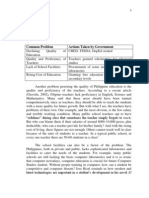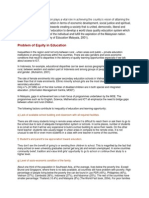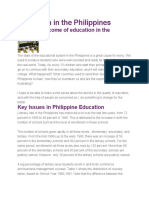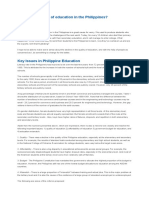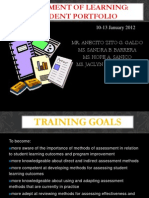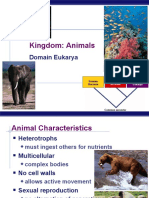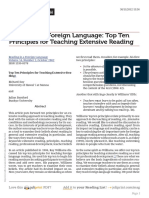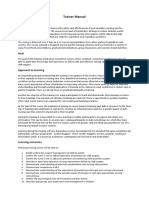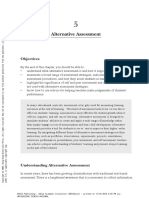The Current Problems in Philippine Education
The Current Problems in Philippine Education
Uploaded by
Doods GaldoCopyright:
Available Formats
The Current Problems in Philippine Education
The Current Problems in Philippine Education
Uploaded by
Doods GaldoOriginal Title
Copyright
Available Formats
Share this document
Did you find this document useful?
Is this content inappropriate?
Copyright:
Available Formats
The Current Problems in Philippine Education
The Current Problems in Philippine Education
Uploaded by
Doods GaldoCopyright:
Available Formats
1 THE CURRENT PROBLEMS IN PHILIPPINE EDUCATION Anecito Zito Gorduiz Galdo, MA An almost barren tree, with rotten fruits.
That is how the Philippine educational system is often described. On the roots of the tree are the many factors and forces that shape the Philippine Educational system including but not limited to colonization history, corrupt political system, and poverty. On the branches are the problems besetting our educational system: lack of teachers, lack of resources, lack of standards, etc. Indeed, the Philippines educational system is besieged with so many problems; however, there is hope in reforming the system. And there is a clamor for reforms within the education bureaucracy, its culture and its leadership; there is also the call to reform the curriculum and set standards; and there is the call to improve teacher education and training. There have been many reforms, there have been many programs but they seem to be inadequate in curing the ails of Philippine educational system (Balmores, n.d.). In this paper, the major problems that are considered besetting the Philippine education are discussed. These are presented in the matrix below: Common Problem Actions Taken by Government Declining Quality of CHED, TESDA, DepEd created Education Quality and Proficiency of Teachers granted scholarships for advanced Teachers studies Lack of School Facilities Procurement of some important facilities in laboratories Rising Cost of Education Granting free education to elementary and secondary levels The quality of education is declining (EDCOM, 1992). It is for this reason that CHED, TESDA, and DepEd were created and mandated to focus on the different levels of education. Many felt that the curriculum set by the Department of Education (DepEd) and the Commission on Higher Education (CHED) is not enough for a more competitive in the modern world. Some said that some subjects are lacking in substance like Mathematics and Science, both are the bulk of most of the educational institution in different countries. Here in the Philippines, many said that these subjects should be taught comprehensively and intensively because it will be the backbone of the countrys development in the near future. This is why Thailand, Malaysia and China outpaced the Philippines in terms of economical and industrial growth because these countries invested in the fields of Mathematics and Sciences. In fact, the best institution in the South-East Asian region is the National University of Singapore (NUS) and their course offerings are in these fields that the Philippines should need to develop.
Another problem pestering the quality of Philippine education is the quality and proficiency of the teachers. According to a recent article (Gerochi, 2002), Filipino teachers lack proficiency in English, Science and Mathematics. Many said that these areas should have been trained comprehensively since as teachers, they should be able to teach the students with a more quality for future growth. But with what I see, the teachers have problems of their own. One example, and the most obvious, is the low salary and terrible working condition. Many public school teachers opt to have sidelines during class that sometimes the teacher simply forgets to teach. But who can blame them if their salaries of around 8000-10,000 pesos, plus deductible, who can a teacher provide for his/her family? And with the rising cost of living, these figures are not enough. Others cannot teach well in class because of the ratio of students to a teacher. In a typical public school, in every one teacher there are 50-60 students in a class! The school facilities can also be a factor of the problem. The Philippines, both in private and public, lacks sophisticated laboratories and facilities to cater the needs of the students. For example, many public schools are still lacking the basic computer laboratories and it is so ironic that computer nowadays, computer education is crucial for future Computer Studies student. Without proper training in computer, how can a student be competitive and computer literate? Jose Rizal reminds us how modern and latest technologies are important in a students development in his novel El Filibusterismo. Like in the novel, the laboratory equipment are stored shut in a cabinet and never to be used in class because of the insufficient number of equipment. And when it is shown in class, it is presented like a monstrance of a priest! And prophetic as it seems, Rizals time is happening all over again in our contemporary times. Lastly, a common problem of our Philippine education is the rising cost of sending a child to school. Private schools charges skyrocketing tuition and miscellaneous fees to a student that parents are having a hard time to cope with the rising cost of education. Even sending a child in a public school doesnt fare better since even the poorest of the poor cannot afford to send a child in school. I remember vividly a story of a public school teacher with a pupil of him. He said that this student was so poor that teachers pay for everything so she can go to school. The teachers dont mind this sacrifice because the student is so bright and intelligent. She never went to college after high school since she cannot really afford it anymore. What saddened the teachers is that this student passed UP but with no scholarship. Right now, many see education not as necessity but a luxury they cannot afford (Reyes, 2002). The state of Philippine education is indeed sad and disheartening. We probably are all asking whos to blame for all this mess. But we cannot simply point finger since we all have responsibilities to solve these problem. The government tries its best to give the country and it seemed not enough. But we should not blame the government entirely since it is just not the
governments problems. It is the problem of each and every one of us. If we want the highest quality of education in the country, we should work together to solve this problem. As a teacher, these problems will be a big cross to bear. But if I can help solve this problem in my own little way, the cross can be lighter and easier to bear. This is the bitter cup of a teacher to bear. But we must remember that the teacher and every one of us will determine the course of our countrys development through education. Even Rizal said that for a country to progress, education is the key to that success. Solving the problems of Philippine education is a long way to go but if we work for the better, we can attain that quality education we all hope for the best.
References: Balmores, N. (n.d.) The Quality of Higher Education in the Philippines, in Manalang (ed.) Philippine Education: Promise and Performance, UP Press. Barro, R. and Sala-i-Martin (1995). Economic Growth. McGrawHill, Inc. EDCOM. 1992. Report of the Congressional Educational Commission. Gerochi, H. (2002) Rate of Return to Education in the Philippines, Preliminary estimates for PDE Paper, UP School of Economics. Reyes, C. (2002) The Poverty Fight: Have We Made An Impact? PIDS 25th Aniversary Symposium Series on Perspective Papers. Paper available in RePEc: See citation data || Full description at Econpapers
You might also like
- Research Paper "Lack of Classroom"Document12 pagesResearch Paper "Lack of Classroom"MarkAnthonyLasalaAleta82% (34)
- The Crisis of Public Education in The PhilippinesDocument4 pagesThe Crisis of Public Education in The PhilippinesDoods Galdo100% (5)
- The Crisis of Public Education in The PhilippinesDocument4 pagesThe Crisis of Public Education in The PhilippinesDoods Galdo100% (5)
- The Leader Who Had No Title - A Modern Fable On Real Success in Business and in Life (Book Description)Document10 pagesThe Leader Who Had No Title - A Modern Fable On Real Success in Business and in Life (Book Description)JoeDabid75% (4)
- The Four Roles of A ReaderDocument15 pagesThe Four Roles of A Readerapi-398545121No ratings yet
- Master of Arts in Nursing: DR. Gloria D. Lacson Foundation Colleges, IncDocument3 pagesMaster of Arts in Nursing: DR. Gloria D. Lacson Foundation Colleges, Inclouie roderosNo ratings yet
- Eng.2 LM Unit 1 v.1Document132 pagesEng.2 LM Unit 1 v.1jess_gavino100% (7)
- Stanislavski - A Biography (Art Ebook) PDFDocument404 pagesStanislavski - A Biography (Art Ebook) PDFa.lionel.blaisNo ratings yet
- For Lit & Low 1 Student Book: by Donna Bowler, Successintesl Vancouver, 2012Document15 pagesFor Lit & Low 1 Student Book: by Donna Bowler, Successintesl Vancouver, 2012successinteslNo ratings yet
- Ac - Asca Lesson Plan TemplateDocument3 pagesAc - Asca Lesson Plan Templateapi-341833868No ratings yet
- Common Problem Actions Taken by GovernmentDocument3 pagesCommon Problem Actions Taken by GovernmentEvangie PaguiriganNo ratings yet
- What Are The Common Problems of The Philippine Educational SystemDocument9 pagesWhat Are The Common Problems of The Philippine Educational SystemPrincess Lhala100% (3)
- Current Issues in EducationDocument3 pagesCurrent Issues in EducationAnonymous T3O9poFpNo ratings yet
- PS: State of Phil. EducationDocument4 pagesPS: State of Phil. EducationKabataan Party-ListNo ratings yet
- Educ 100 Reaction Paper 1Document2 pagesEduc 100 Reaction Paper 1Tyrone GarciaNo ratings yet
- Master of Arts in Nursing: DR. Gloria D. Lacson Foundation Colleges, IncDocument3 pagesMaster of Arts in Nursing: DR. Gloria D. Lacson Foundation Colleges, IncLouis Carlos RoderosNo ratings yet
- Philippine Education: Issues and ConcernsDocument2 pagesPhilippine Education: Issues and ConcernsVee FelicianoNo ratings yet
- Factors Affecting The Deterioration of Educational System in The PhilippinesDocument6 pagesFactors Affecting The Deterioration of Educational System in The PhilippinesJim Dandy Capaz100% (11)
- Problems and Issues in Philippine EducationDocument16 pagesProblems and Issues in Philippine EducationRoMeoNo ratings yet
- HIST 1 FORUMS EducationDocument4 pagesHIST 1 FORUMS EducationMa Lizalyn BarizoNo ratings yet
- Privilege Speech of RepDocument3 pagesPrivilege Speech of RepJune Lantaya100% (2)
- Problems and Issues in Philippine EducationDocument3 pagesProblems and Issues in Philippine Educationjerryclaire81% (31)
- Issues and Concerns of Philippine Education Through The YearsDocument3 pagesIssues and Concerns of Philippine Education Through The YearsSweet MpndnNo ratings yet
- Problem of Equity in Education: A) Lack of Available School Building and Classroom With All Required FacilitiesDocument15 pagesProblem of Equity in Education: A) Lack of Available School Building and Classroom With All Required FacilitiesSuriani DaudNo ratings yet
- Short DiscourseDocument2 pagesShort DiscoursetagoashleyyNo ratings yet
- Task 2Document4 pagesTask 2Jon GraniadaNo ratings yet
- Issues in Philippine EducationDocument2 pagesIssues in Philippine EducationLorenz Smith100% (1)
- Education in The PhilippinesDocument11 pagesEducation in The PhilippinesMarvin Glenn Arevalo CanayNo ratings yet
- What Has Become of Education in The PhilippinesDocument5 pagesWhat Has Become of Education in The PhilippinesMark Abion ValladolidNo ratings yet
- The Importance of Education QualityDocument4 pagesThe Importance of Education QualityCeline Angela LinNo ratings yet
- Midterm Exam AnswersDocument11 pagesMidterm Exam AnswersJannet FuentesNo ratings yet
- 3 Pressing Issue EssayDocument7 pages3 Pressing Issue EssayIrene CosteloNo ratings yet
- CompreDocument4 pagesComprenap caindecNo ratings yet
- Key Issues in Philippine EducationDocument6 pagesKey Issues in Philippine EducationLynne CabatayNo ratings yet
- CM - Javier ReactionPaper ModernTrendsinEducDocument2 pagesCM - Javier ReactionPaper ModernTrendsinEduccarlmarthy.javierNo ratings yet
- ArticlesDocument8 pagesArticleschristianNo ratings yet
- The Biggest Problem Fracing Our Educational System TodayDocument3 pagesThe Biggest Problem Fracing Our Educational System TodayKrizzle Jane PaguelNo ratings yet
- Concrete Problems in Philippine EducationDocument16 pagesConcrete Problems in Philippine EducationVirgo0% (1)
- Latest Issues of Education: Philippine SettingDocument4 pagesLatest Issues of Education: Philippine SettingJohn Benedict RamirezNo ratings yet
- Shortage of School Buildings, Textbook, and EquipmentDocument2 pagesShortage of School Buildings, Textbook, and EquipmentMary Rhose Dela Cruz100% (1)
- Reflection in Seminar in Issues and Problem On EucationDocument2 pagesReflection in Seminar in Issues and Problem On Eucationmark bryan maculadaNo ratings yet
- Philippine Educational SystemDocument5 pagesPhilippine Educational SystemBernNo ratings yet
- Formal EducationDocument4 pagesFormal Educationbpa.galsimaaNo ratings yet
- Main Problems in Cambodian Education SystemDocument7 pagesMain Problems in Cambodian Education SystemKIEN FORCEFIDELE100% (9)
- EDUCATION-CASE-STUDYDocument4 pagesEDUCATION-CASE-STUDYworkatalk6No ratings yet
- Philippine EducationDocument7 pagesPhilippine EducationArnulfo Villasfer SantiagoNo ratings yet
- Education Case StudyDocument16 pagesEducation Case StudyLokesh ChawlaNo ratings yet
- The Philippine Educational System Pursues The Achievement of Excellent Undergraduates in The Elementary and Secondary LevelDocument2 pagesThe Philippine Educational System Pursues The Achievement of Excellent Undergraduates in The Elementary and Secondary LevelClaireNo ratings yet
- Column Article Re Issues in Philippine Education by Herman LagonDocument5 pagesColumn Article Re Issues in Philippine Education by Herman LagonHerman LagonNo ratings yet
- EducationDocument9 pagesEducationchsudheer291985No ratings yet
- Term PaperDocument13 pagesTerm Paperjean petateNo ratings yet
- Factors Affecting The Deterioration of EducationalDocument3 pagesFactors Affecting The Deterioration of EducationalJackie DumaguitNo ratings yet
- Reflected On The Presented Issues in The PhilippineDocument11 pagesReflected On The Presented Issues in The PhilippineNikki AlkongaNo ratings yet
- Education in IndiaDocument10 pagesEducation in IndiaPrasanthi LagumNo ratings yet
- Learning Crisis EssayDocument3 pagesLearning Crisis EssayHajra Ajmal SafiNo ratings yet
- 7 Key Issues and Problems of Philippine EducationDocument5 pages7 Key Issues and Problems of Philippine EducationJennylou MacaraigNo ratings yet
- Issues and Concerns With Phil Educ System - ReactionDocument2 pagesIssues and Concerns With Phil Educ System - ReactionDante BalinawaNo ratings yet
- Technological Issues of Philippine EducationDocument10 pagesTechnological Issues of Philippine EducationgadzNo ratings yet
- (8612) 2nd Assignment RIZWANDocument32 pages(8612) 2nd Assignment RIZWANmr.manzoor1965No ratings yet
- MARY JEAN B. EMPENG MA-206-Midterm-ExaminationDocument3 pagesMARY JEAN B. EMPENG MA-206-Midterm-ExaminationMary Jean EmpengNo ratings yet
- Deben Ser Maestros o Profesionales Los Que Enseñen A Nuestros HijosDocument4 pagesDeben Ser Maestros o Profesionales Los Que Enseñen A Nuestros HijosJose Luis Camarena JimenezNo ratings yet
- Reforms in The Philippine Education System: The K To 12 ProgramDocument6 pagesReforms in The Philippine Education System: The K To 12 ProgramJenny-Vi LogronioNo ratings yet
- Status and Prospects of Science and Mathematics Education in The PhilippinesDocument20 pagesStatus and Prospects of Science and Mathematics Education in The PhilippinesPeter Philip M. Perez100% (18)
- Unraveling Deterioration in The Quality of Philippine EducationDocument4 pagesUnraveling Deterioration in The Quality of Philippine EducationMariel Yanes GarciaNo ratings yet
- A Communal Cure: How to Heal Our Educational System's SicknessFrom EverandA Communal Cure: How to Heal Our Educational System's SicknessNo ratings yet
- Portfolio AssessmentDocument43 pagesPortfolio AssessmentDoods GaldoNo ratings yet
- Weather and Climate: Slide 1 of 26Document15 pagesWeather and Climate: Slide 1 of 26Doods GaldoNo ratings yet
- Curriculum and Its ElementsDocument5 pagesCurriculum and Its ElementsDoods Galdo100% (6)
- World's Major CommunitiesDocument27 pagesWorld's Major CommunitiesDoods GaldoNo ratings yet
- Republic Act No 4670Document6 pagesRepublic Act No 4670Doods GaldoNo ratings yet
- Renewable NonrenewableDocument16 pagesRenewable NonrenewableatulsemiloNo ratings yet
- Reproductive System FunctionDocument22 pagesReproductive System FunctionDoods GaldoNo ratings yet
- Common Problems and Actions Taken in The Philippine Education SystemDocument3 pagesCommon Problems and Actions Taken in The Philippine Education SystemDoods Galdo88% (16)
- Chapter 9. Weather and ClimateDocument40 pagesChapter 9. Weather and ClimateDoods Galdo100% (1)
- Plant and Animal TissuesDocument27 pagesPlant and Animal TissuesDoods GaldoNo ratings yet
- Principles of Inheritance: Mendel's Legacy: Wouldn't It Be Nice If People Understood It Better?Document40 pagesPrinciples of Inheritance: Mendel's Legacy: Wouldn't It Be Nice If People Understood It Better?Doods Galdo100% (1)
- The Atmosphere: Composition and StructureDocument31 pagesThe Atmosphere: Composition and StructureDoods GaldoNo ratings yet
- THE Biosphere and Its Natural ResourcesDocument28 pagesTHE Biosphere and Its Natural ResourcesDoods GaldoNo ratings yet
- Animal Microbe InteractionsDocument50 pagesAnimal Microbe InteractionsDoods GaldoNo ratings yet
- Kingdom: Animals: Domain EukaryaDocument25 pagesKingdom: Animals: Domain EukaryaDoods GaldoNo ratings yet
- 1nitrogen CycleDocument45 pages1nitrogen CycleDoods GaldoNo ratings yet
- Oral Report CriteriaDocument1 pageOral Report CriteriaDoods GaldoNo ratings yet
- Animal Nutrition: AP BiologyDocument34 pagesAnimal Nutrition: AP BiologyDoods Galdo100% (1)
- Why Do PlantsDocument13 pagesWhy Do PlantsDoods GaldoNo ratings yet
- Questions For Oral Recitation in Environmental ScienceDocument1 pageQuestions For Oral Recitation in Environmental ScienceDoods GaldoNo ratings yet
- Earth Science Midterm RecitationDocument3 pagesEarth Science Midterm RecitationDoods GaldoNo ratings yet
- Creating Effective Powerpoint Presentations: Anecito G. Galdo, MAEM Assistant Professor Pamantasan NG Lungsod NG PasigDocument11 pagesCreating Effective Powerpoint Presentations: Anecito G. Galdo, MAEM Assistant Professor Pamantasan NG Lungsod NG PasigDoods GaldoNo ratings yet
- Basic Statistical Tools: There Are Lies, Damn Lies, and Statistics...... (Anonnymous)Document37 pagesBasic Statistical Tools: There Are Lies, Damn Lies, and Statistics...... (Anonnymous)Doods GaldoNo ratings yet
- Welcome: Please Take A Moment To Fill Out A Name Tent and To Work On The Task That Has Been Placed at Each SeatDocument17 pagesWelcome: Please Take A Moment To Fill Out A Name Tent and To Work On The Task That Has Been Placed at Each SeatDoods GaldoNo ratings yet
- Hci Lesson PlanDocument2 pagesHci Lesson PlanDaryl Ivan Empuerto Hisola100% (1)
- Besplug Mariah ResumeDocument3 pagesBesplug Mariah Resumeapi-287407006No ratings yet
- ECourse ChecklistDocument1 pageECourse ChecklistCurtis RoseNo ratings yet
- Task Based SyllabusDocument12 pagesTask Based Syllabusdewi astutik100% (6)
- Reading in A Foreign Language. Top Ten Principles For Teaching Extensive Reading. Day, Bamford-1Document6 pagesReading in A Foreign Language. Top Ten Principles For Teaching Extensive Reading. Day, Bamford-1PegieNo ratings yet
- UW-Platteville HPE Program Physical Education Lesson Plan TemplateDocument6 pagesUW-Platteville HPE Program Physical Education Lesson Plan Templateapi-284670729No ratings yet
- Training and DevelopmentDocument35 pagesTraining and Developmentgregory dsouza100% (3)
- Aural Skills II SyllabusDocument6 pagesAural Skills II SyllabusJohn SkinnerNo ratings yet
- Teaching Philosophy Cover LetterDocument3 pagesTeaching Philosophy Cover Letterdavid_stephens_29No ratings yet
- Yudof at KPCC 3systems Summit Jan 13Document9 pagesYudof at KPCC 3systems Summit Jan 13Chris NewfieldNo ratings yet
- Trainer Manual For Nusring Care Saves LivesDocument15 pagesTrainer Manual For Nusring Care Saves LivesEko AwaluddinNo ratings yet
- Music Lesson Plan Dec 7 2016Document3 pagesMusic Lesson Plan Dec 7 2016api-350189121No ratings yet
- Assure Lesson PlanDocument6 pagesAssure Lesson Planapi-301349748No ratings yet
- O Level Maths P2 November 2012 Mark Scheme 21Document6 pagesO Level Maths P2 November 2012 Mark Scheme 21Kelvin MuzaNo ratings yet
- The Lion Collection Book27Document38 pagesThe Lion Collection Book27Roxana Laura MoldovanNo ratings yet
- The Lady or The TigerDocument24 pagesThe Lady or The TigerVictorNo ratings yet
- CivicsDocument1 pageCivicsNorizah Baba100% (1)
- Alternative AssessmentDocument24 pagesAlternative AssessmentSol100% (2)
- Chromatic Triadic Approach (Garzone) PDFDocument2 pagesChromatic Triadic Approach (Garzone) PDFgilgoos100% (4)
- Calm20 Course OutlineDocument3 pagesCalm20 Course Outlineapi-241505726No ratings yet
- KKIPS SLAC Action Plan in SchoolDocument6 pagesKKIPS SLAC Action Plan in SchoolEmz Mzz33% (3)
- Using Cooperative Learning in Teaching Reading ComprehensionDocument13 pagesUsing Cooperative Learning in Teaching Reading ComprehensionirfanNo ratings yet
- Jocelyn Baker Resume Oct 2013Document2 pagesJocelyn Baker Resume Oct 2013api-171848653No ratings yet
- Nepal-Tibet Cultural Relations Andthe Zhva-Dmar-Pa (Shamarpa) Lamas of TibetDocument21 pagesNepal-Tibet Cultural Relations Andthe Zhva-Dmar-Pa (Shamarpa) Lamas of TibetYesheKunkhyenNo ratings yet









